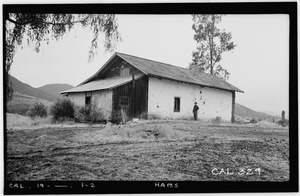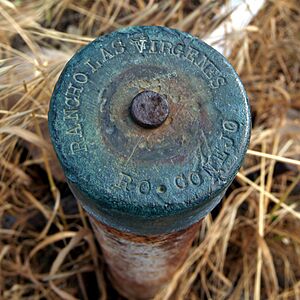Rancho Las Vírgenes facts for kids

Rancho Las Vírgenes was a very large piece of land, about 17,760 acres (71.9 km2), given out as a land grant in early California history. It was located in the Santa Monica Mountains and Simi Hills, in what is now western Los Angeles County, California. Today, this area includes cities like Agoura Hills, Oak Park, and Westlake Village.
The land was first given in 1802 by the Spanish Governor José Joaquín de Arrillaga to Miguel Ortega. But after Ortega died in 1809, the land was left empty. Later, in 1834, Nemecio Domínguez and Domingo Carrillo received a new land grant for it from the Mexican government. The name Nuestra Señora la Reina de las Vírgenes means "Our Lady the Queen of the Virgins" in English.
Contents
History of Rancho Las Vírgenes

Long ago, the Tongva Native American people lived in this area. Their village was called Wisyáxnga, which means "place of the pine."
Early Spanish Grant
In 1800, Bartholomé Miguel de Ortega received a temporary Spanish land grant for this area. It was called Rancho Las Vírgenes. When Miguel Ortega died in 1809, his family moved back to Los Ángeles. By 1817, the rancho was empty. Since the first grant was only temporary, the land was considered free. The Franciscans at Mission San Fernando Rey de España then asked the governor if they could use the land for their cattle.
Mexican Land Grant
In 1833, Nemesio Domínguez and Domingo Antonio Ygnacio Carrillo asked the Mexican Governor Figueroa for the land known as Las Vírgenes. They said the mission didn't need the land and that it had been empty since Ortega's death. In 1834, they were officially given Rancho Las Vírgenes.
In 1837, Governor Alvarado added more land to the grant, called the Triunfo addition. This was given to José Maria Dominguez, Nemecio's father. A new map, or diseño, was drawn for the rancho.
Maria Antonia Machado de Reyes Takes Over
In 1845, Maria Antonia Machado de Reyes bought Rancho Las Vírgenes from her uncle, Jose Maria Dominguez. Maria Antonia was a widow with 14 children. Her husband, José Jacinto Reyes, was the son of Juan Francisco Reyes.
After California Became Part of the U.S.
After the Mexican-American War ended in 1848, California became part of the United States. The Treaty of Guadalupe Hidalgo said that existing land grants would be respected.
In 1851, the U.S. government passed a law requiring people to prove their land ownership. Maria Antonia Machado de Reyes filed her claim for Rancho Las Vírgenes in 1852. Her claim was approved in 1854, and again by a U.S. court in 1857. The land was officially confirmed as hers in 1883, measuring about 8,885 acres (36.0 km2).
This confirmed area was much smaller than the original grant. This happened because of a mistake in reading the 1837 map. The U.S. government thought the missing land was public land. So, they allowed other people to settle there. This extra land was opened for "homesteading" in 1896, meaning people could claim it to build homes and farms.
A Legal Challenge
José Maria Dominguez had given his part of the rancho to his son, Jose Apolonio Dominguez. Jose Apolonio then left it to his daughter, Dominga Dominguez. Dominga later sued a homesteader named Brigido Botiller and others. She wanted to get back the land of Rancho Las Vírgenes. In a case called Botiller v. Dominguez, the US Supreme Court agreed that the original grant to Nemecio Dominguez and Domingo Carrillo in 1834 was valid. However, because no claim for that specific grant had been made to the Land Commission, no official land title could be given out.
Historic Sites of the Rancho
These are some important historical places connected to Rancho Las Vírgenes:
Reyes Adobe
The Reyes Adobe home was built around 1850 by Jose Paulino Reyes. He was the son of Jose Jacinto Reyes and Maria Antonia Machado. This adobe house is now owned by the City of Agoura Hills.
Vejar Adobe
The Vejar Adobe was a two-story house built around 1850 by Juan Crisostomo Vejar. He married Maria Engracia Reyes, who was the daughter of Maria Antonia Machado de Reyes. This adobe was a stop for the Butterfield Overland Stage in the 1860s and was known as Vejar Station. The building stood in Agoura until the early 1900s, when it was taken down.



